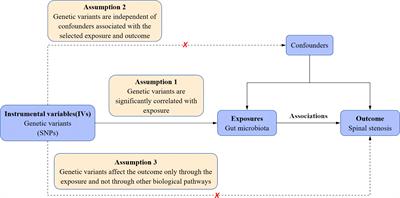Association between gut microbiota and spinal stenosis: a two-sample mendelian randomization study
Introduction: Considerable evidence has unveiled a potential correlation between gut microbiota and spinal degenerative diseases.

However, only limited studies have reported the direct association between gut microbiota and spinal stenosis. Hence, in this study, we aimed to clarify this relationship using a two-sample mendelian randomization (MR) approach. Materials and Methods: Data for two-sample MR studies was collected and summarized from genome-wide association studies (GWAS) of gut microbiota (MiBioGen, n = 13, 266) and spinal stenosis (FinnGen Biobank, 9, 169 cases and 164, 682 controls).
The inverse variance-weighted meta-analysis (IVW), complemented with weighted median, MR-Egger, weighted mode, and simple mode, was used to elucidate the causality between gut microbiota and spinal stenosis. In addition, we employed mendelian randomization pleiotropy residual sum and outlier (MR-PRESSO) and the MR-Egger intercept test to assess horizontal multiplicity. Cochran’s Q test to evaluate heterogeneity, and “leave-one-out” sensitivity analysis to determine the reliability of causality. Finally, an inverse MR analysis was performed to assess the reverse causality. Results: The IVW results indicated that two gut microbial taxa, the genus Eubacterium fissicatena group and the genus Oxalobacter, have a potential causal relationship with spinal stenosis. Moreover, eight potential associations between genetic liability of the gut microbiota and spinal stenosis were implied. No significant heterogeneity of instrumental variables or horizontal pleiotropy were detected. In addition, “leave-one-out” sensitivity analysis confirmed the reliability of causality. Finally, the reverse MR analysis revealed that no proof to substantiate the discernible causative relationship between spinal stenosis and gut microbiota. Conclusion: This analysis demonstrated a possible causal relationship between certain particular gut microbiota and the occurrence of spinal stenosis. Further studies focused on the mechanism of gut microbiota-mediated spinal stenosis can lay the groundwork for targeted prevention, monitoring, and treatment of spinal stenosis.
Read the full article at the original website
References:
